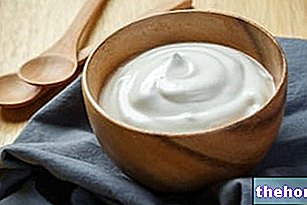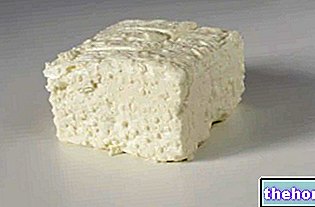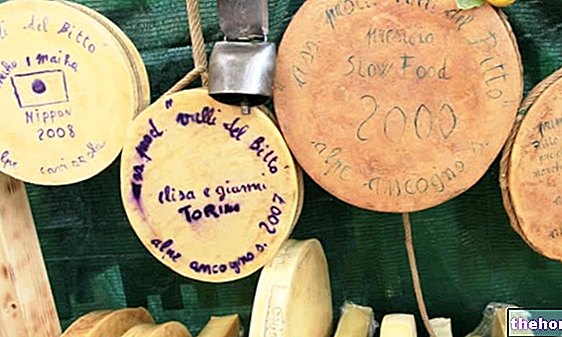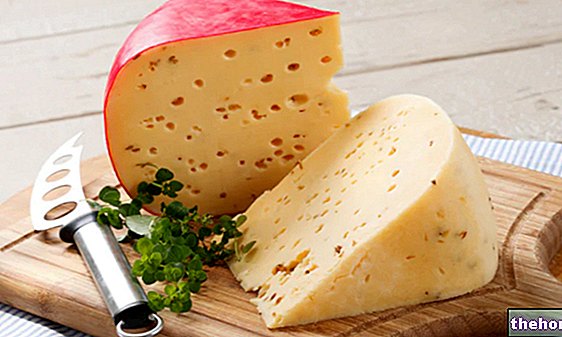Generality
Montasio is a dairy product similar to Latteria, Carnia and Friulano.
It is a typical cheese of Northern Italy.

The name "montasio" is related to the typical origin of the alpine group of the Julian Alps, rich in pastures that have always been used for mountain pastures.
Motasio is one of the most exported cheeses abroad.
Nutritional Characteristics
Montasio is a product that belongs to the II fundamental group of foods (milk and derivatives).
Its nutritional function is above all to supply proteins rich in essential amino acids, calcium and vitamin B2.
It is considered a medium-light cheese, as (in the context of cheeses) the fat content is just below average. Nevertheless, it still represents a fairly caloric food.
Energy comes mainly from lipids, followed by proteins and finally by traces of carbohydrates.
Montasio fatty acids are mainly saturated, peptides of high biological value and simple sugars (lactose).
Among the vitamins, the concentrations of the water-soluble riboflavin (B2) and the fat-soluble A (retinol) stand out.
As for the mineral salts, the levels of calcium, phosphorus and sodium stand out.
The cholesterol level is considerable.
It does not contain fibers.
It is gluten-free but contains small concentrations of lactose which, in case of hypersensitivity (severe intolerance), can create various problems (diarrhea, abdominal pain, bloating, vomiting, etc.).
On the other hand, it has the characteristic of being well tolerated even by subjects with intestinal affections.
In medicine, the use of montasio (and a few other derivatives of milk, such as grana) in the diet of people recovering from infectious complications of the digestive system is known.
Excessive consumption of montasio is not recommended in case of overweight and hypercholesterolemia.
Thanks to the concentration of calcium and phosphorus, this cheese is recommended in the diet of those who require a significant intake of these minerals (subjects in growth, menopause, etc.).
On the other hand, the excess of sodium makes montasio totally unsuitable for the diet of hypertensive people.
The average portion of montasio is about 80 g (330 kcal).
Description
Montasio is a cheese made exclusively from cow's milk.
It is produced with a semi-cooked, pressed pasta, which becomes semi-hard or hard depending on the seasoning.
There are mainly 3 types of montasio:
- Semi-hard, matured for a few months (prevalence of the montasio produced).
- Typical of the Alps, hard, aged for 5-12 months.
- Hard, to scratch, with maturation of over 12 months (very old).
ATTENTION! What is explained below refers to the semi-hard montasio, matured for a few months.
The cheese is packaged in large cylindrical-shaped pieces, with a low side of 6-10 cm and a weight between 5-9 kg.
It has a smooth, regular and flexible rind.
It has a pale yellow (straw-yellow) paste with a tenacious but fairly elastic consistency. It shows some small evenly scattered holes, called “partridge eye” (by the heterolactic bacteria).
On the palate, montasio is moderately salty and quite savory.
Contains 36-43% fat (calculated on dry matter), 35-45% water, 0.5-1.0% lactose (shows an average "lactase activity), 0.5-1 , 0% calcium.
It has a proteolysis index of 12-15 and a lipolysis index of around 5.
The pH is 5.2 at the beginning of maturation and 6 at the end of maturation.
Introduction to production
The production of Montasio is quite faithful to that of other Alpine cheeses.
Fresh milk or a mixture of semi-skimmed milk (from the evening milking) and whole milk (from the morning milking) is used.
In the past, whey grafting from natural crops was used; today this occurs only in artisanal productions, while at an industrial level, selected lactic ferments are preferred.
The curd is broken, cut into small pieces and kept stirring.
When the mass becomes consistent, it is heated over direct heat or steam until it reaches a temperature of 48-50 ° C.
The curd is left to settle in the bottom and the whey is extracted, filtering everything with cloths.
The solid mass is distributed in the molds placed under the press to speed up the drainage of the residual whey (also favored by acidification).
The cheese is then subjected to salting.
The wheels are then detached in the casere for maturing.
The latter lasts for 2-6 months at a temperature of 10-15 ° C.
Gastronomic notes
As far as the gastronomic aspect is concerned, montasio is a typical table cheese, even if the one aged over a year (stravecchio) lends itself to being grated on pasta or risotto.
Risotto with Pears and Cheese
Problems with playing the video? Reload the video from youtube.
- Go to the Video Page
- Go to the Video Recipes Section
- Watch the video on youtube
Even if it does not fall within the specification, it is necessary to mention the montasio aged in merlot and cabernet wine must, called “formaio embriago”. In a few days this product reaches a level of ripeness equal to several months.
The recommended wine pairings for montasio are with:
- Rosato delle Gravi from Friuli.
- Merlot del Collio.
- Riviera del Garda red.
- Terre di Franciacorta red wine.
- Teroldego Rotaliano.
- Sassicaia.
NB. The wine pairing depends on the level of maturation.
Milk, Dairy Products and Cheeses Asiago Brie Burrata Caciocavallo Rennet Camembert Cheddar Milk Cream Crescenza Emmental Feta Milk Flakes Fontina Herbal Cheeses Lean Cheeses Cheeses rich in calcium Gorgonzola Gouda Grana Padano Gruyere Kéfalair Adapted milk Artificial milk Condensed milk Asphyxiated milk Goat's milk Sheep's milk Rice milk Soy milk Powdered milk and concentrated milk Skimmed and semi-skimmed milk Lactose-free milk Milk Vegetable milk Dairy products Lerdammer Mascarpone Montasio Buffalo mozzarella Mozzarella Whipped cream Cooking cream Fresh cream Parmigiano Reggiano Pecorino Philadelphia Primo Sale Provolone Ricotta Robiola Roquefort Scamorza Sottilette Squacquerone Taleggio Tomino Yogurt OTHER ARTICLES MILK AND DERIVATIVES Categories Alcoholic foods Meat Cereals and derivatives Sweeteners Sweets Offal Fruit Dried fruit Milk and derivatives Legumes Oils and fats Fish and fishery products Cold cuts S pezie Vegetables Health recipes Appetizers Bread, Pizza and Brioche First courses Second courses Vegetables and Salads Sweets and Desserts Ice creams and sorbets Syrups, liqueurs and grappa Basic preparations ---- In the kitchen with leftovers Carnival recipes Christmas recipes Light diet recipes Women's Day, Mum, Dad Recipes Functional Recipes International Recipes Easter Recipes Recipes for Celiacs Recipes for Diabetics Recipes for Holidays Recipes for Valentine's Day Recipes for Vegetarians Protein Recipes Regional Recipes Vegan Recipes




























